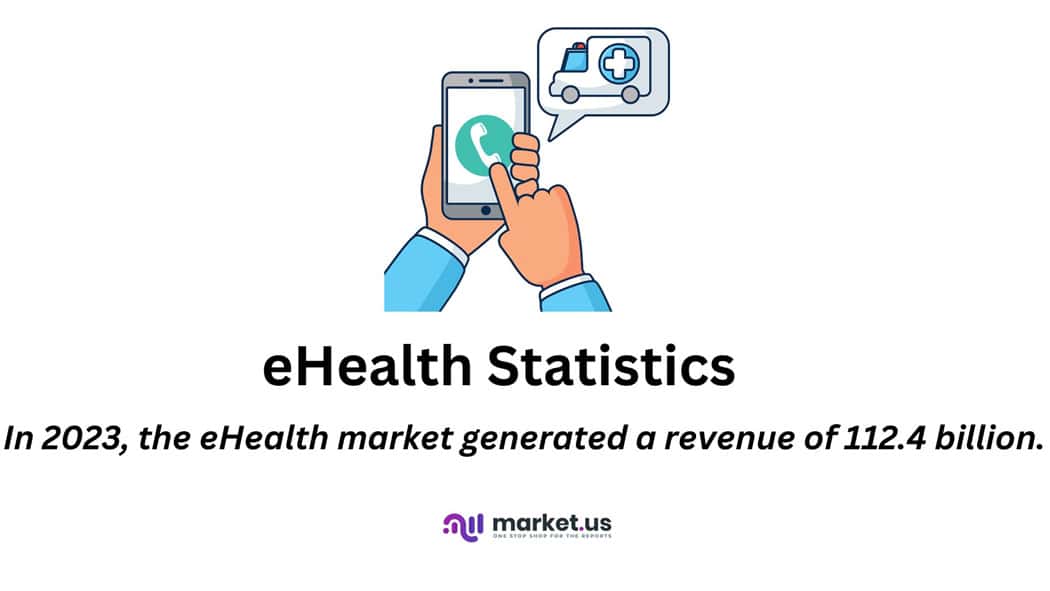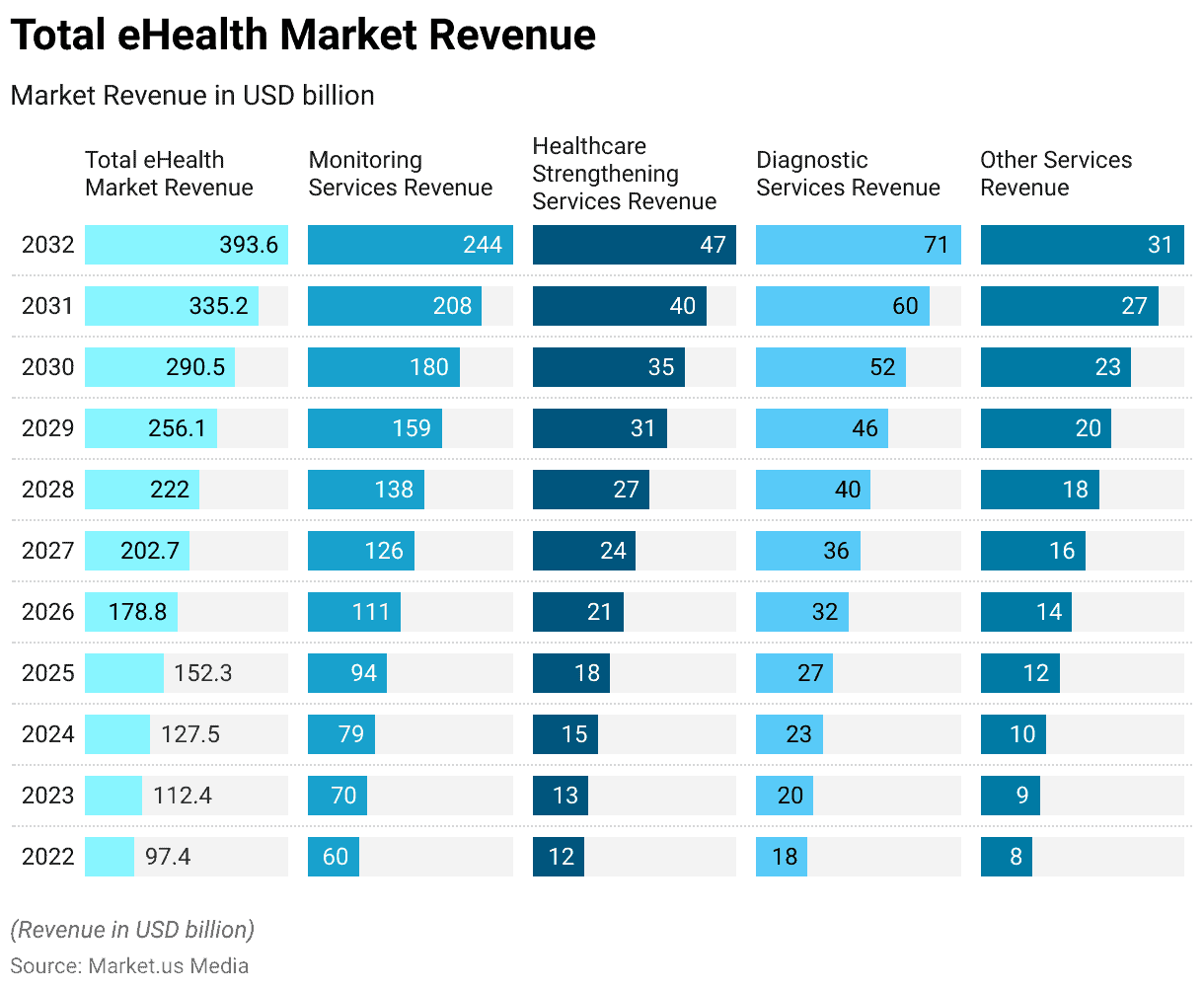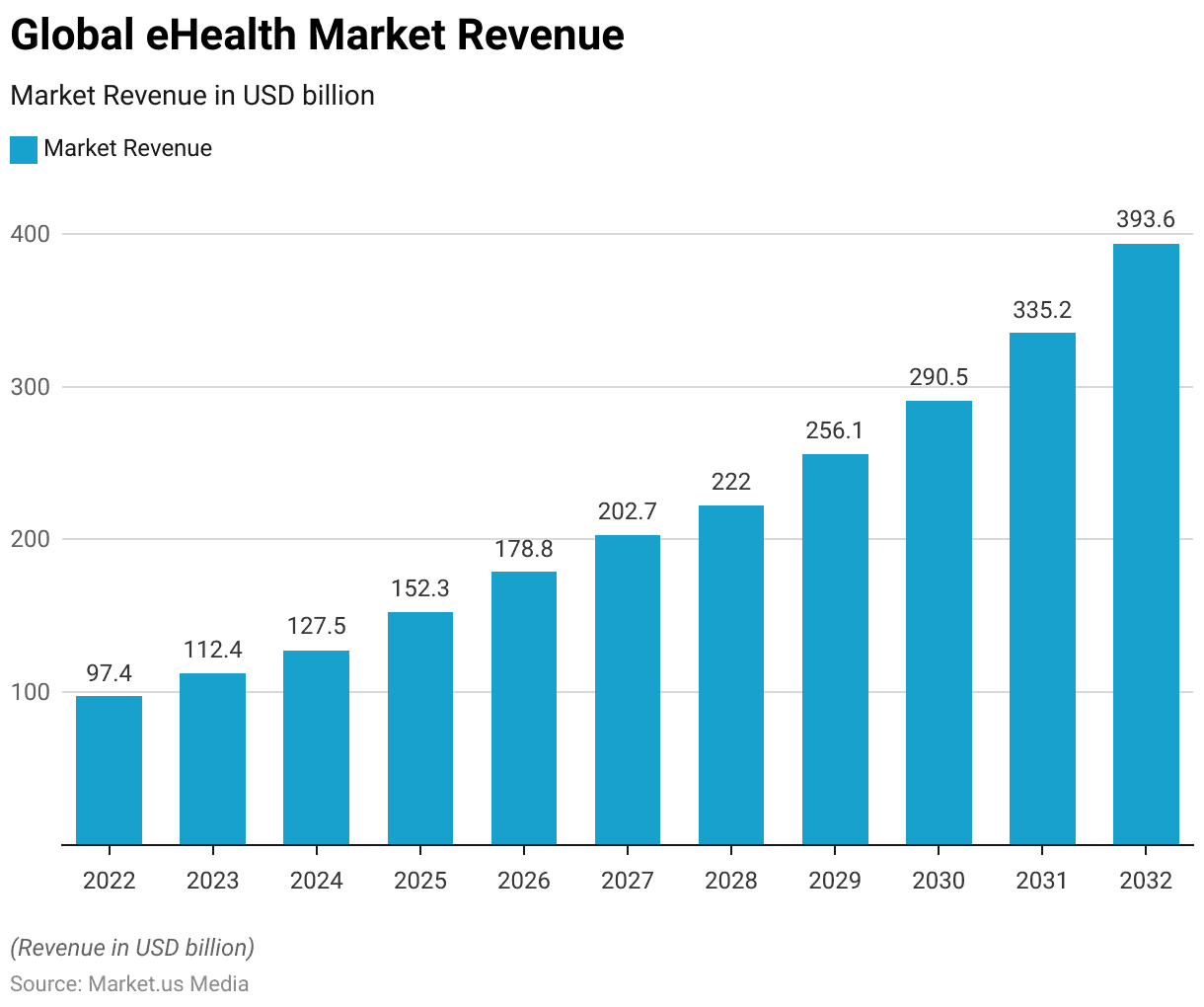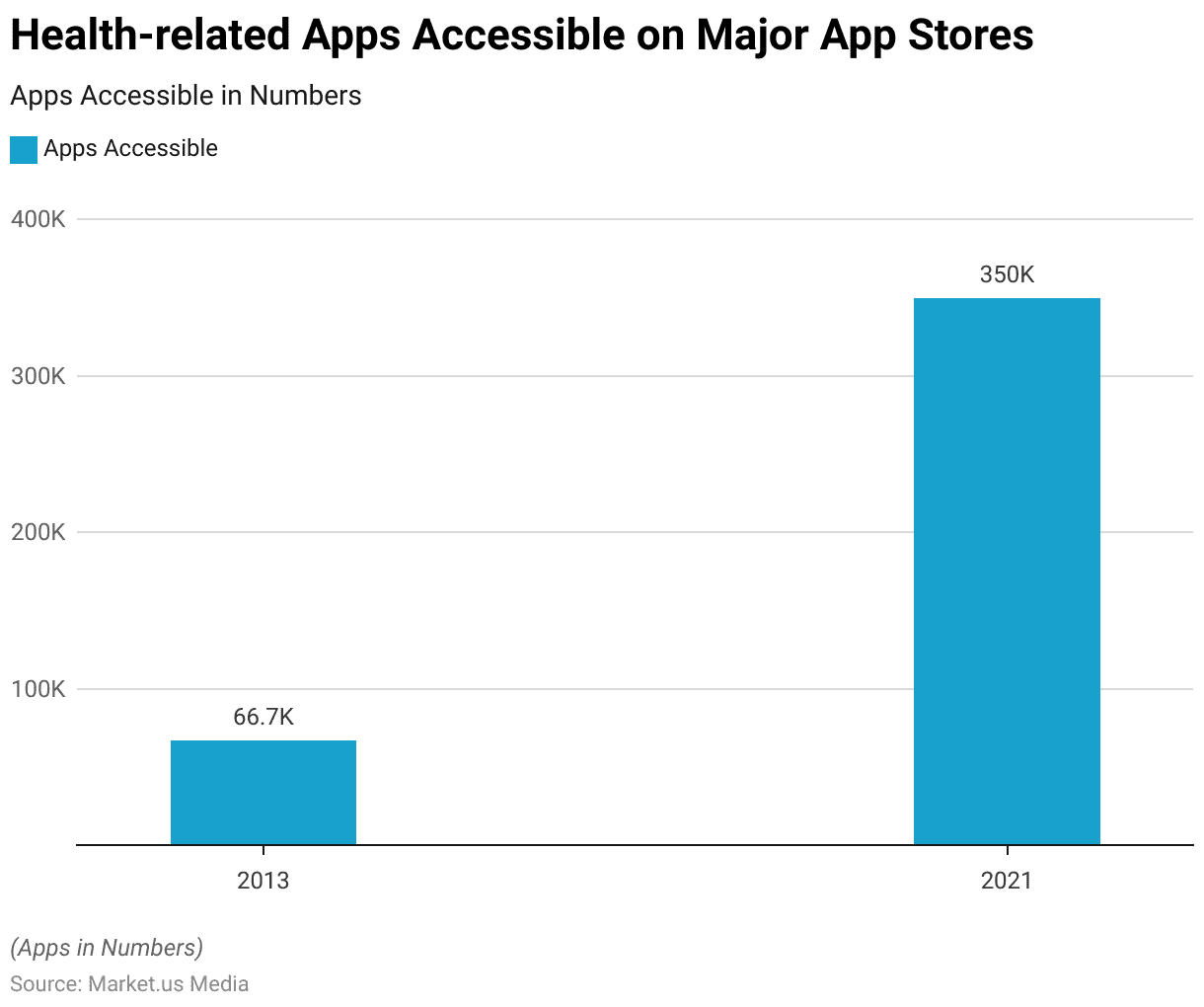Table of Contents
Introduction
eHealth Statistics: eHealth, or electronic health, is the fusion of healthcare and technology. It employs digital instruments such as electronic health records, telemedicine, mobile applications, wearable devices, and health information systems to elevate patient care and healthcare operations.
eHealth offers advantages like enhanced care, reduced expenses, greater accessibility, and increased patient involvement.
However, it also introduces difficulties like safeguarding data and ensuring systems work together smoothly. In sum, it’s revolutionizing healthcare by utilizing technology to improve patient results.

Editor’s Choice
- The global eHealth market is experiencing substantial growth at a CAGR of 15.4%
- In 2022, the market’s revenue stood at USD 97.4 billion, and this figure is anticipated to increase to USD 393.6 billion in 2032.
- In 2022, the total eHealth market revenue reached USD 97.4 billion. Monitoring services accounted for the largest share with USD 60 billion, followed by healthcare strengthening services at USD 12 billion, diagnostic services at USD 18 billion, and other services at USD 8 billion.
- Approximately 60% of EHR users express contentment with the system, while only 28% have voiced dissatisfaction.
- Ninety-three percent of healthcare professionals find telehealth to be an acceptable means of delivering patient care, with 60% expressing “very satisfied” experiences.
- In 2021, the total number of wearable devices shipped reached 533.6 million, encompassing various categories like hearables, watches, wristbands, and other wearables.
- In 2021, investors poured nearly $45 billion into the digital health sector, marking a significant doubling of the previous year’s investment and the highest amount since 2010.

eHealth Market Statistics
Global eHealth Market Size Statistics
- The global eHealth market is experiencing substantial growth at a CAGR of 15.4%, with revenues projected to follow an upward trajectory over the next decade.
- In 2022, the market’s revenue stood at USD 97.4 billion, and this figure is anticipated to increase to USD 112.4 billion in 2023.
- The growth trend continues with expected revenues of USD 127.5 billion in 2024 and USD 152.3 billion in 2025.
- As healthcare systems increasingly embrace digital solutions, the eHealth market is set to reach USD 178.8 billion in 2026 and USD 202.7 billion in 2027.
- By 2028, it is forecasted to exceed the USD 220 billion mark at USD 222.0 billion.
- The momentum is expected to persist, with revenues reaching USD 256.1 billion in 2029 and USD 290.5 billion in 2030.
- Looking further ahead, the market is projected to achieve remarkable growth, with anticipated revenues of USD 335.2 billion in 2031 and USD 393.6 billion in 2032.
- This continuous expansion reflects the increasing importance and adoption of eHealth technologies and solutions in the global healthcare landscape.
(Source: Market.us)

Global eHealth Market Size – By Service Statistics
- The global eHealth market is poised for substantial growth in the coming years, as indicated by the projected revenue figures.
- In 2022, the total eHealth market revenue reached USD 97.4 billion. Monitoring services accounted for the largest share with USD 60 billion, followed by healthcare strengthening services at USD 12 billion, diagnostic services at USD 18 billion, and other services at USD 8 billion.
- The market is expected to witness a steady expansion, with 2023 forecasted to see a total revenue of USD 112.4 billion, driven by increased demand for monitoring, healthcare strengthening, diagnostic, and other services.
- This growth trend is expected to continue throughout the forecast period. With the market reaching a substantial USD 393.6 billion by 2032.
- Monitoring services are projected to maintain their lead, with USD 244 billion in revenue, followed by diagnostic services at USD 71 billion, healthcare strengthening services at USD 47 billion, and other services at USD 31 billion.
- These figures reflect the growing significance of eHealth solutions in modern healthcare systems, promising better monitoring, diagnostics, and overall healthcare services for individuals worldwide.
(Source: Market.us)

Global eHealth Market Size – By End-user Statistics
- The global eHealth market is characterized by a diverse range of end-users. Each plays a crucial role in shaping the landscape of digital healthcare.
- Among these, healthcare providers occupy the largest share, commanding a significant 53% of the market.
- This includes hospitals, clinics, and healthcare facilities that leverage eHealth solutions to enhance patient care, streamline operations, and improve overall healthcare delivery.
- Healthcare payers, with a substantial 22% market share, represent insurance companies and organizations responsible for covering healthcare costs.
- They are increasingly embracing eHealth technologies to optimize claims processing, monitor patient outcomes, and manage costs more effectively.
- Healthcare consumers, comprising 18% of the market share, are a vital demographic driving the demand for eHealth solutions.
- Individuals are becoming more proactive in managing their health, utilizing mobile health apps, and wearable devices. Telemedicine services to monitor their well-being and access medical advice conveniently.
- Lastly, other end-users, accounting for 7% of the market, encompass a variety of entities such as pharmaceutical companies. Research institutions, and government agencies, contribute to the eHealth ecosystem in distinct ways.
(Source: Market.us)

eHealth Infrastructure Statistics
Electronic Health Records (EHRs)
- A recent survey by the ONC reveals that nearly all hospitals nationwide have integrated certified Electronic Health Records (EHRs) into their operations.
- Approximately 60% of EHR users express contentment with the system, while only 28% have voiced dissatisfaction.
- More than 83% of healthcare professionals find EHRs to be beneficial in managing tasks like patient records, prescription orders, clinical notes, medications, problem lists, and accessing lab results.
- In terms of EHR adoption rates in the United States, there has been a significant uptick, rising from 40% in 2012 to 67% in 2017.
- Furthermore, almost 95% of hospitals eligible for the Medicare and Medicaid EHR Incentive Program have successfully met the criteria for meaningful use of certified health IT.
- According to reports, primary care doctors lead in the adoption of certified Electronic Health Records (EHRs) with a rate of 79%.
- In community healthcare centers, medical practitioners have an impressive EHR adoption rate of 98%, with approximately three-quarters using certified EHRs.
- The utilization of EHR features such as viewing, downloading, and transmitting health records online has witnessed a substantial increase from 2013 to the present, surging from 10% in 2013 to over 70% now.
- Four out of five non-federal acute care hospitals have already embraced a basic EHR system that includes clinician notes, and almost all of them have access to certified EHRs.
- Furthermore, more than 80% of small, rural, and critical access hospitals have adopted a fundamental EHR system, including clinician notes.
(Source: Health IT Dashboard)
Take advantage of our unbeatable offer - buy now!

eHealth in Telemedicine Statistics
- Around 80% of individuals have experienced telemedicine services at least once.
- Approximately 76% of people aged 55 and older have utilized telemedicine. In rural areas, telemedicine is used by about 73% of the population.
- Remarkably, 98% of transgender patients have reported using telemedicine.
- Patients opt for telemedicine primarily to handle prescription needs, with a preference rate of 61%.
- Additionally, 51% of patients favor telemedicine for seeking care for minor illnesses.
- In the upcoming five years, consumers anticipate an increased utilization of virtual healthcare offerings.
- Ninety-three percent of healthcare professionals find telehealth to be an acceptable means of delivering patient care, with 60% expressing “very satisfied” experiences.
- Additionally, 89% of clinicians state that telemedicine is a satisfactory approach for follow-up care. Only 5% of virtual healthcare appointments necessitate an in-person examination.
(Source: Rock Health, Bain, Neurology)
Mobile Health (mHealth) Apps
- mHealth applications have become highly prevalent in the healthcare sector, covering a wide range of medical conditions and usage scenarios.
- According to a report from the IQVIA Institute in July 2021, there are over 350,000 health-related apps accessible on major app stores worldwide, with over 90,000 new additions in 2020.
- This reflects substantial growth since 2013 when there were merely 66,713 healthcare apps available to consumers.
- While around 54% of the apps in 2020 were related to fitness, lifestyle, and dietary matters, the rest were dedicated to managing specific health conditions. This shift indicates a growing demand for clinically-oriented apps as virtual healthcare continues to expand.
- In 2020, telehealth stood out as the top investment sector in mHealth, drawing in around $1.78 billion in funding.
- Back in 2018, the overall global revenue for the mHealth market reached approximately $28 billion. The future forecasts predict a significant increase to nearly $247 billion by 2025.
- During the most recent assessment period, the Google Play Store featured 54,546 healthcare and medical apps, marking a slight decrease compared to the prior quarter.
- Nevertheless, from the beginning of 2020 to the end of 2021, the number of mHealth apps available to Android users on the Google Play Store continued to rise, surpassing 65,300 in the final quarter of 2021.
(Source: Statista)

Wearable Health Devices
- In 2021, the total number of wearable devices shipped reached 533.6 million. Encompassing various categories like hearables, watches, wristbands, and other wearables.
- Projections indicate that the global smartwatch shipments are expected to exceed 253 million units by 2025.
- In 2020, Fitbit had 31 million active users who engaged with their device at least once a week.
- As per information from a Guardian article in January 2020, there were approximately 18 million users of Garmin watches at that time.
- According to a study conducted by the Journal of Internet Medical Research, 30% of the American population utilizes wearable health devices.
- Deloitte Global’s forecast suggests that in 2022, around 320 million wearable devices focused on consumer health and wellness will be shipped globally.
- By 2024, it’s expected that this number will grow to nearly 440 million units. Driven by the introduction of new products and an increasing willingness among healthcare providers to incorporate them.
- This includes a range of devices, encompassing smartwatches aimed at consumers and medical-grade wearables. Often referred to as “smart patches,” they are commonly prescribed by healthcare professionals but are increasingly accessible for direct purchase.
(Source: Statista, Strategy Analytics, NIH.gov, Deloitte)
eHealth Investment Statistics
- In 2021, investors poured nearly $45 billion into the digital health sector. Marking a significant doubling of the previous year’s investment and the highest amount since 2010.
- However, in 2022, funding decreased to $23.3 billion, though it remained the second-highest annual funding level within the given time frame.
- In 2015, all the funding allocated for eHealth programs in the 28 European Union countries was sourced from public funding.
- India hosts approximately 5,295 health-tech startups, with 133 of them being funded eHealth startups.
- The projected growth of the eHealth market in the country is estimated to reach $10.6 billion by 2025.
- However, about the overall healthcare market potential. Which is expected to reach $638 billion by 2025, the eHealth sector will account for only 1.6%.
- This underscores the substantial room for expansion and the significant opportunities available to the eHealth industry.
- In 2015, in Europe, by World Bank gross national income per capita groupings. 68 percent of the funding available for eHealth programs in high-income per capita countries was private or commercial.
(Source: Statista, Inc 42, Statista)
Recent Developments
Mergers and Acquisitions:
- There is an expected increase in M&A activity within the digital health sector, especially involving companies at the forefront of AI integration.
- This trend is driven by the need to maintain a competitive edge in the rapidly evolving healthcare landscape.
- Companies that develop AI-driven health tech are particularly sought after as they offer innovative solutions in diagnostics, drug discovery, and patient care management.
Technological Innovations:
- Significant advancements have been made in remote patient monitoring (RPM) technologies. RPM is increasingly covered under various health plans, including Medicare and Medicaid. Which is likely to boost the demand for companies providing these technologies. This sector’s growth is fueled by its capacity to enhance patient outcomes through continuous health data monitoring.
- The adoption of HL7 FHIR (Fast Healthcare Interoperability Resources) standards is being accelerated through incentive programs by eHealth Exchange. This program aims to reduce healthcare costs and improve patient care by streamlining the exchange of patient data across different healthcare platforms.
Product Launches:
- Stryker has launched several new products aimed at improving healthcare outcomes. Notable among these are the AxSOS 3 Ankle Fusion System, designed for less customization in surgeries, and the Niagara Lateral Access System for spinal deformities.
- These innovations highlight the company’s focus on developing technology that adapts to varied patient needs.
Virtual Care and Telehealth:
- The virtual care sector has seen a rise in mergers and acquisitions, driven by its increasing popularity and the extended governmental waivers that allow for broader telemedicine services.
- This segment’s growth is expected to continue, fueled by the convenience and cost-effectiveness of virtual care solutions.
Investment in Mental Health Technologies:
- There is growing investor interest in mental health technologies, particularly teletherapy platforms and mental health apps.
- These technologies have become crucial in providing accessible mental health services and are supported by expanded reimbursement options. Including new payments for virtual health and wellness coaching.
Conclusion
eHealth Statistics – Electronic health, known as eHealth, is revolutionizing the healthcare landscape using digital tools. It enhances patient care, reduces expenses, and increases patient involvement.
Although it faces challenges such as data security, the eHealth field is expanding swiftly, with promising advancements ahead.
Innovations like AI and personalized medicine are poised to revolutionize the delivery of healthcare. In essence, eHealth offers substantial prospects for healthcare stakeholders to elevate the well-being of patients on a global scale.
FAQs
eHealth, short for electronic health, is a field that combines healthcare with technology. It involves the use of digital tools and technologies to improve the delivery, management, and access to healthcare services and information.
eHealth tools include electronic health records (EHRs), telemedicine, mobile health apps, wearable devices like smartwatches, and health information systems.
eHealth enhances patient care by providing healthcare providers with easy access to patient records, improving coordination of care. Increasing accessibility to healthcare services, and promoting patient engagement.
Data security is a concern in eHealth, and efforts are made to protect patient information. Regulations like HIPAA (Health Insurance Portability and Accountability Act) in the United States set standards for data security and patient privacy.
Telemedicine is the remote delivery of healthcare services using technology. It typically involves video consultations between patients and healthcare providers, allowing for diagnosis and treatment without in-person visits.
Discuss your needs with our analyst
Please share your requirements with more details so our analyst can check if they can solve your problem(s)



